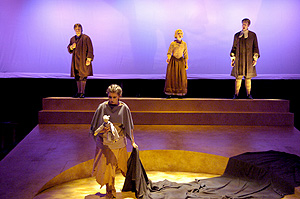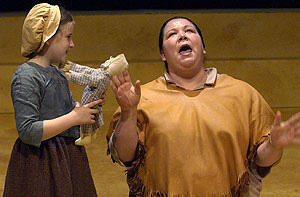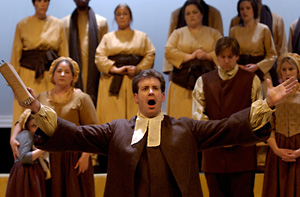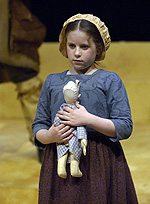![]()
|
The Captivation of Eunice Williams
Overview of the Opera What caused Eunice to forsake her early Puritan years and become the Mohawk woman, A'onkáhte, "she who is planted"? She left behind no written records. The only knowledge of her life comes from others—a passage or two from her brother's diary and reports from English officers stationed near Canada. Yet the conflicts that played out through Eunice's tumultuous life—Native vs. Colonist, French vs. English, Catholic vs. Protestant—remain of vital concern in today's world. In The Captivation of Eunice Williams, composer Paula Kimper (Patience and Sarah, Bridge of San Luis Rey) draws musical inspiration from the several cultures engaged in this struggle. The English colonists brought with them the rich folk music of the British Isles and the solemn hymns of the Puritan Church. The French brought a lively secular music and the soaring Roman Catholic Mass. The Mohawks had their own deep and powerful tradition of Iroquoian music and chant. Inspired by the 300th anniversary of the attack and captivation, this opera uses the power of music and theater to offer a fresh, unique, and compelling perspective on an extraordinary American story that speaks directly to the world in which we live. Commissioned as one of a number of perspectives examining the complex legacy of 1704 by the Pocumtuck Valley Memorial Association, The Captivation of Eunice Williams is not "accurate" in the sense that pleases academic historians. Although strongly informed by what is actually known, some historic characters have been combined or imagined, and some events have been creatively interpreted for dramatic purposes.
The Performers
Kariwiiósta: Christina Gagnon Composer: Paula Kimper The Songs
1. Hymn/Sermon (duration 3:02) 3. Are you there? This day (duration 1:53) 4. The planting moon (duration :51) 5. She hears me calling (duration 5:35) 6. Seventeen moons (duration 1:10) 7. Tell her/We survive (duration 2:53) 8. Once, many winters ago (duration 3:55) 9. Tsí'tha kí:ken (duration :20) 10. War song/dream (duration 1:54) 11. I once came falling (duration 2:28) 12. Contradance (duration 1:21) 13. John Williams' daughter (duration 2:10) 14. Ohne i'ke (duration 1:12) 15. Revelation (duration 2:57) 16. Dream quartet (duration 3:57) 17. Sermon (duration 1:16) 18. Condolence/one day (duration 3:38)
Credits These songs were recorded by James LaGrand of LaGrandice Audio in collaboration with WFCR and recorded at the Reid Theatre at Deerfield Academy in Deerfield, MA on July 24, 2004. The audio files were engineered by Tony Jillson at Ratite Studios. For more information on the opera go to www.eunicewilliams.com.
|
![]()
About This Site
Resources
Glossary
Teachers' Guide
Site Map
How To
© 2020 PVMA / Memorial Hall Museum



